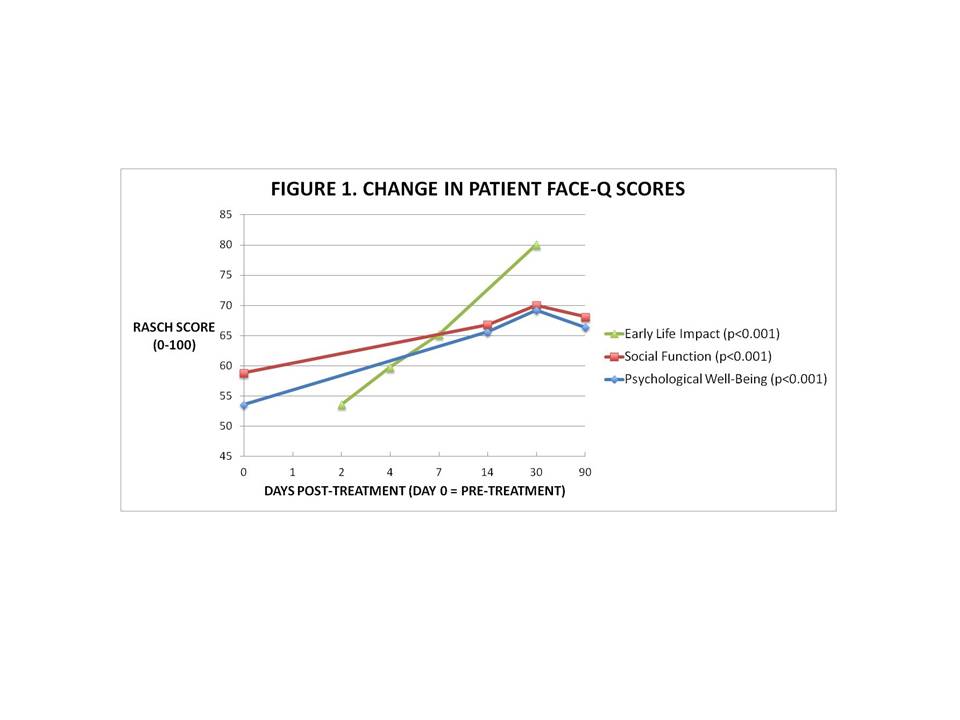|
|
|
|
|
Back to 2014 Annual Meeting Abstracts
Measuring Quality of Life in Facial Aesthetic Patients: Development and Validation of the FACE-Q Psychological Well-being, Social Function, Early Life Impact, and Satisfaction with Outcome and Decision Scales
Jonathan A. Schwitzer, BA1, Anne F. Klassen, DPhil2, Stefan J. Cano, PhD3, Andrea L. Pusic, MD1.
1Memorial Sloan-Kettering Cancer Center, New York, NY, USA, 2McMaster University, Hamilton, ON, Canada, 3Plymouth University Peninsula Schools of Medicine and Dentistry, Plymouth, United Kingdom.
Background: The FACE-Q is a new patient-reported outcome instrument (PRO) comprised of a series of independently functioning scales and adverse effects checklists designed to measure outcomes important to facial aesthetic patients (surgical and nonsurgical). Here we describe the development and validation of FACE-Q quality of life and process of care scales.
Methods: The FACE-Q was developed according to international guidelines for PRO instrument development. Through qualitative methods we identified concepts important to facial aesthetic patients, which were used to inform upon the following items and scales: Psychological Well-being, Social Function, Early Life Impact of Treatment, Satisfaction with Outcome of Treatment, and Satisfaction with Decision to have Treatment. These scales were field tested in 12 plastic surgery and dermatology practices across North America between 2010- 2012. Additionally, two pharmaceutical companies used the Early Life Impact scale in international clinical trials; facelift and minimally invasive lip treatment, respectively. Rasch Measurement Theory (RMT) and traditional psychometric methods were used to evaluate scale reliability and validity. Clinical change was assessed using pre- and post-treatment Rasch transformed scores, comparing paired t-tests and calculating Kazis effect sizes and standardized response means.
Results: A total of 702 patients completed the FACE-Q scales. Mean age was 47.8 years (range 18-89, SD 14.3); 9.4% of patients were male. Most common procedures included lip treatment (n=287 patients), facelift (n=196), rhinoplasty (n=87), orthognathic surgery/genioplasty (n=36), and skin resurfacing (n=33). RMT methods resulted in the validation of five FACE-Q scales (Psychological Well-being, Social Function, Early Life Impact, Satisfaction with Decision, and Satisfaction with Outcome). Rasch transformed scores (range 0-100) were found to change significantly pre- to post-treatment, including in Psychological Well-being (53.6 (pre) v 66.4 (day 90 post-treatment), p<0.001) and Social Function (58.8 (pre) v 68.1 (day 90 post-treatment), p <0.001). Early Life Impact scores increased significantly over time as well (53.6 (day 2 post-treatment) v 80.1 (day 30), p<0.001). See Figure 1 for Rasch transformed scores.
Conclusions: The FACE-Q was developed to provide the research and clinical community with a comprehensive outcome measurement tool for patients undergoing any facial aesthetic procedure. The scales are psychometrically sound and clinically meaningful, with excellent reliability and validity. They enable accurate quality of life measurement assessments in patients undergoing aesthetic facial procedures, that will further evidence-based practice.

Back to 2014 Annual Meeting Abstracts
|
|




